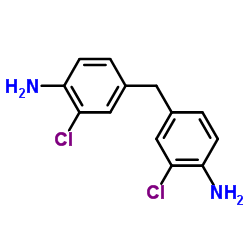4,4'-methylene-bis-(2-chloroaniline)

4,4'-methylene-bis-(2-chloroaniline) structure
|
Common Name | 4,4'-methylene-bis-(2-chloroaniline) | ||
|---|---|---|---|---|
| CAS Number | 101-14-4 | Molecular Weight | 267.154 | |
| Density | 1.44 | Boiling Point | 412.0±40.0 °C at 760 mmHg | |
| Molecular Formula | C13H12Cl2N2 | Melting Point | 102-107 °C(lit.) | |
| MSDS | Chinese USA | Flash Point | 203.0±27.3 °C | |
| Symbol |



GHS07, GHS08, GHS09 |
Signal Word | Danger | |
|
[Resolution of overlapping mass spectra of azobiphenyl dyes by subwindow factor analysis technique].
Se Pu 19(2) , 184-7, (2001) Subwindow factor analysis(SWFA) has been proven to be an effective data processing technique. In this paper, it is applied to the resolution of overlapping GC-MS peaks. A two-component sample of azobiphenyl dyes (3,3'-dichlorobenzidine, 4,4'-methylene-bis-(2-... |
|
|
New approaches to extraction techniques in determination of 4,4'-methylenebis(2-chloroaniline) in air and water solutions.
Talanta 93 , 117-21, (2012) Extraction techniques for 4,4'-methylenebis(2-chloroaniline) (MOCA) in air samples and water solutions were developed and compared. Classic techniques for air sampling of MOCA were enhanced by incorporating a derivatization step (3,5-dinitrobenzoyl chloride s... |
|
|
Oxidative DNA damage estimated by plasma 8-hydroxydeoxyguanosine (8-OHdG): influence of 4, 4'-methylenebis (2-chloroaniline) exposure and smoking.
J. Occup. Health 49(5) , 389-98, (2007) Oxidative DNA damage may play an important role in the human carcinogenic process. Recently, we reported a case of bladder cancer among 4, 4'-methylenebis (2-chloroaniline) (MBOCA)-exposed workers. By measuring the plasma level of 8-hydroxydeoxyguanosine (8-O... |
|
|
A survey of occupational exposure to 4,4'-methylene-bis (2-chloroaniline) (MbOCA) in the UK.
Ann. Occup. Hyg. 53(5) , 499-507, (2009) The main objective of the study was to gather information about the current controls and levels of exposure to 4,4'-methylene-bis (2-chloroaniline) (MbOCA) in a representative cross section of workplaces that use it to manufacture polyurethane elastomers. The... |
|
|
Bladder cancer screening and monitoring of 4,4'-methylenebis(2-chloroaniline) exposure among workers in Taiwan.
Urology 66(2) , 305-10, (2005) Transitional cell carcinoma of the urinary bladder is associated with occupational exposure to 4,4'-methylenebis(2-chloroaniline) (MBOCA). A program to monitor MBOCA levels in the work environment and to screen for bladder cancer was performed at four MBOCA m... |
|
|
Biological monitoring of workers exposed to 4,4'-methylene-bis-(2-orthochloroaniline) (MOCA). II. Comparative interest of "free" and "total" MOCA in the urine of exposed workers.
Int. Arch. Occup. Environ. Health 72(4) , 229-37, (1999) The objectives of the study were to investigate the best urinary marker of exposure to MOCA in urine samples of exposed workers and to study its applicability in exposure evaluation in polyurethane resin production plants. In addition, our intention was to co... |
|
|
Simultaneous analysis of urinary 4,4'-methylenebis(2-chloroaniline) and N-acetyl 4,4'-methylenebis(2-chloroaniline) using solid-phase extraction and liquid chromatography/tandem mass spectrometry.
Rapid Commun. Mass Spectrom. 21(24) , 4073-8, (2007) Analysis of 4,4'-methylenebis(2-cholroaniline) (MOCA) or its metabolites in urine has been considered as the appropriate method to assess MOCA exposures through inhalation and skin absorption. MOCA and its metabolite, N-acetyl 4,4'-methylenebis(2-chloroanilin... |
|
|
Mutagenicity of N-OH-MOCA (4-amino-4'-hydroxylamino-bis-3,3'-dichlorodiphenylmethane) and PBQ (2-phenyl-1,4-benzoquinone) in human lymphoblastoid cells.
Toxicol. Lett. 95(3) , 205-10, (1998) The genotoxic potential of two occupationally significant chemicals, 4,4'-methylene-bis-2-chloroaniline (MOCA) and 2-phenyl-1,4-benzoquinone (PBQ), was explored by monitoring the induction of mutations at the HPRT locus of AHH-1 human lymphoblastoid cells. Ex... |
|
|
Occupational applications of a human cancer research model.
J. Occup. Environ. Med. 40(2) , 125-35, (1998) Many bladder cancers are indolent, and since there are no biomarkers to predict progression, the prognosis is problematic. Utilizing an in vitro/in vivo human uroepithelial cell (SV-HUC.PC) transformation system, we investigated several molecular events occur... |
|
|
Cancer incidence and exposure to 4,4'-methylene-bis-ortho-chloroaniline (MbOCA).
Occup. Med. (Lond.) 59(6) , 402-5, (2009) To monitor the occurrence of cancer in a recently defined cohort of UK workers engaged in the manufacture of polyurethane elastomers using 4,4'-methylene-bis-ortho-chloroaniline.A cohort of 308 male production workers from seven factories have been enumerated... |